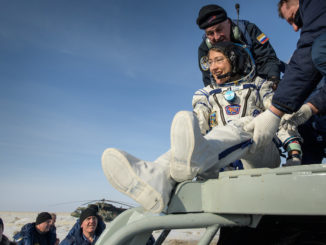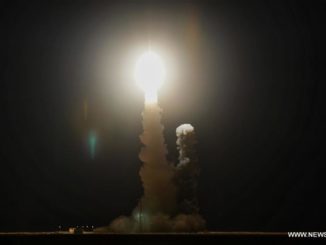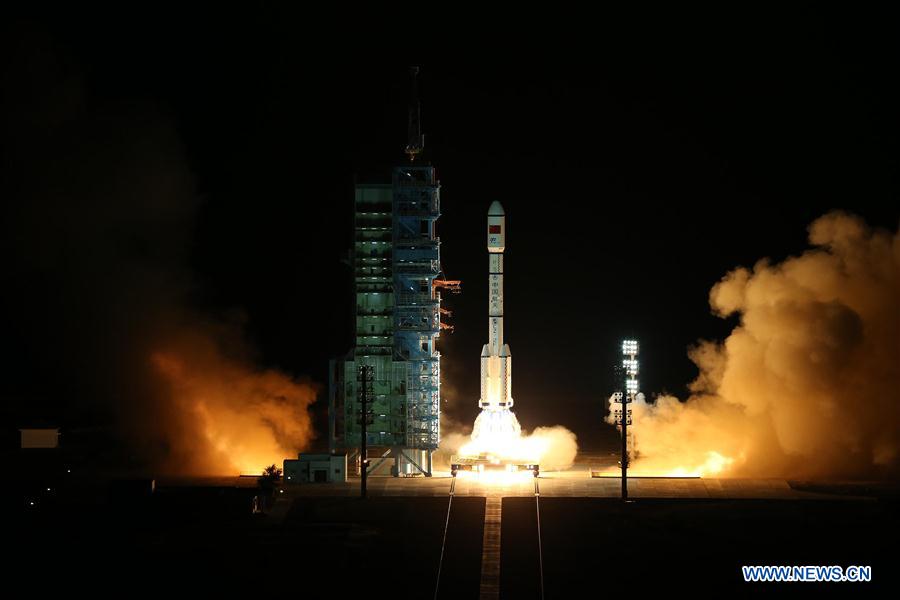
The next stepping stone in China’s human spaceflight program launched Thursday, delivering a destination and living quarters to orbit for two astronauts preparing for liftoff next month on a planned 33-day expedition, the country’s longest space mission to date.
The Tiangong 2 space lab rode a Long March 2F launcher into orbit from the Jiuquan space center in northwestern China’s Gobi Desert.
In live video broadcast from Jiuquan by Chinese state television, access platforms and electrical umbilical arms swung away from the 170-foot-tall (52-meter) Long March 2F T2 launcher in the final minutes of the countdown, and eight engines ignited with a puff of orange exhaust at 1404 GMT (10:04 a.m. EDT; 10:04 p.m. Beijing time) Thursday.
The rocket climbed in a clear nighttime sky, and a camera fixed to the vehicle showed the Long March 2F’s four strap-on YF-20B booster engines dropping away about two-and-a-half minutes into the flight. Moments later, the core stage jettisoned and the second stage’s main engine and vernier steering thrusters ignited as planned.
The upper stage shut down and deployed the 19,000-pound (8.6-metric ton) Tiangong 2 laboratory around the 10-minute point of the mission, and Chinese officials declared the launch a success.
“Tiangong 2 operates normally, and the orbit injection fulfilled the requirements, and the solar panels are also stretched out,” said Gen. Zhang Youxia, commander-in-chief of China’s human spaceflight program. “I would like to declare the launch mission of the Tiangong 2 space lab has achieved a complete success.”
The failure of a Long March 4C rocket during an Aug. 31 flight with a Chinese Earth observation satellite did not hold up Thursday’s launch. Investigators have traced the failure to the Long March 4C’s third stage, a part of the launcher unrelated to the Long March 2F launcher that blasted off with Tiangong 2.
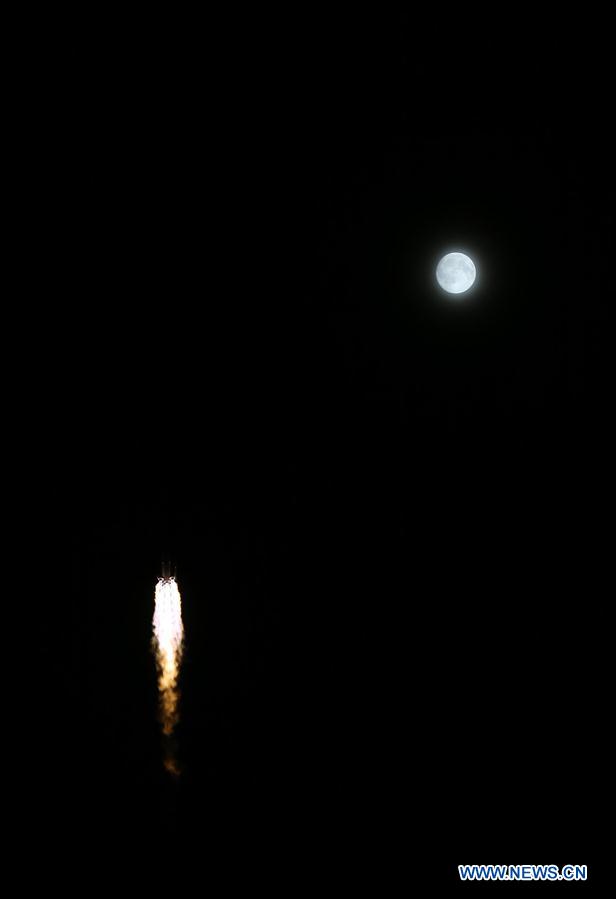
The Tiangong 2 spacecraft is kicking off a two-year mission to conduct a slate of scientific experiments and lay the technological foundation for a Chinese space station set to be assembled in orbit several hundred miles above Earth by 2022.
China’s latest space mission will demonstrate cargo resupply and propellant refueling procedures required for the country’s future space station, and host an array of research experiments developed by Chinese and international scientists, according to senior space officials.
If all goes according to plan, two Chinese astronauts will launch aboard the Shenzhou 11 spacecraft in mid-to-late October in pursuit of the Tiangong 2 space lab. Shenzhou 11 will dock with the spacecraft to form a mini-space station, and astronauts will live and work inside the module for 30 days, officials said.
The Shenzhou 11 mission’s total duration is slated to be 33 days, including flight time before docking and after undocking with Tiangong 2, according to Wu Ping, deputy director of the China Manned Space Agency.
That is more than twice the length of China’s longest-duration piloted spaceflight to date, a 15-day expedition in 2013.
Wu said the astronauts, who have not been publicly identified, will conduct medical experiments, test out maintenance procedures, and help with other research investigations.
The launcher was expected to initially place the Tiangong 2 spacecraft in an egg-shaped transfer orbit with a perigee, or low point, about 120 miles (200 kilometers) above Earth. The module’s on-board thrusters will raise its orbit to an altitude of 238 miles (384 kilometers) in the days after launch.
Ground controllers in Beijing will verify the health of the craft’s propulsion, power supply and communications systems before positioning Tiangong 2 in orbit 244 miles (393 kilometers) up, the prescribed docking altitude for the Shenzhou 11 mission, Wu said in a press conference Wednesday.
She said the launch of Tiangong 2 is the start of a new phase in China’s human spaceflight program.
“In the early stage of the program, we focused on the basic technology for manned space missions, and in the new stage, we will focus more on space experiments and applications,” Wu said.
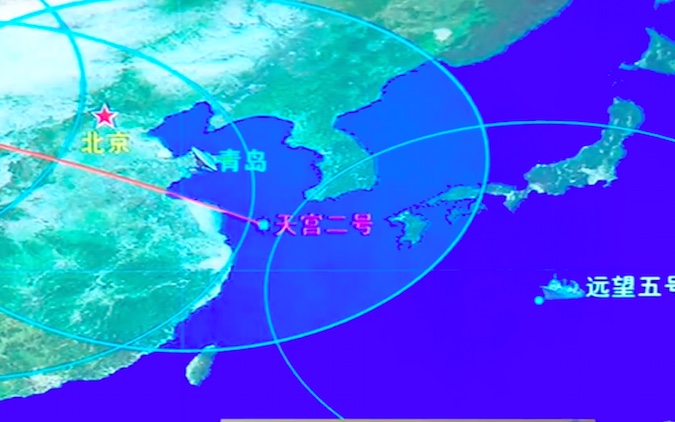
China has launched five crewed space missions since 2003, demonstrating docking and spacewalk techniques on standalone missions and two visits to the Tiangong 1 space lab in 2012 and 2013. Ten Chinese astronauts have flown on the previous expeditions.
Tiangong means “heavenly palace” in English.
The Tiangong 2 spacecraft launched Thursday looks much like the Tiangong 1 module shot into orbit in September 2011, but engineers have overhauled the lab’s interior to make it more comfortable for astronauts, more useful for scientists, and more like the structures that will ultimately make up China’s space station.
“Tiangong 1 was a target spacecraft in order to finish the docking experiments with the Shenzhou spacecraft, but Tiangong 2 is a space lab at its core,” Wu said. “It has two major missions: First is to carry out large-scale space science experiments and space application experiments, including medical experiments, and second is to (support) medium-term space stays for astronauts, propellant refueling and in-orbit maintenance. These are key technologes for the building of space stations.”
Like the precursor Tiangong 1 module, Tiangong 2 measures about 34 feet (10.4 meters) long and 11 feet (3.4 meters) wide. Its two solar array wings will span 60 feet (18.4 meters) tip-to-tip when unfurled in space.
“Tiangong 2 and Tiangong 1 basically look the same from the exterior, but in order to accomplish the above-mentioned missions … we have done a lot of renovations,” Wu said. “First, we have a lot of applications, including space science, Earth observation, science research and application of new technologies, and also we have medical experiment facilities loaded on it.”
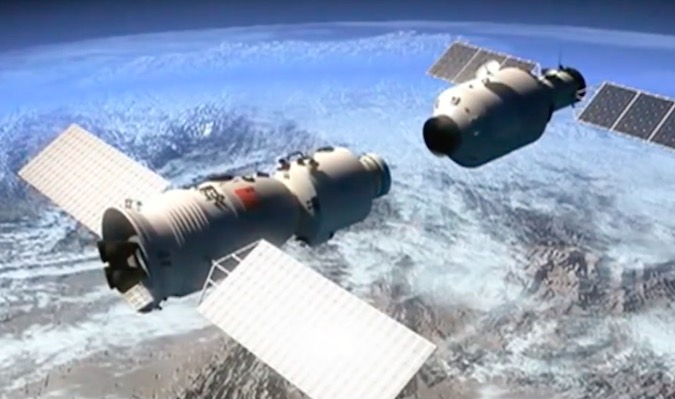
Unlike the earlier mission, Tiangong 2 is equipped to receive fuel deliveries.
“Second, in order to test the technology for propellant refueling, we have done a lot of renovation,” Wu said. “We added compressors so that it can work better during the docking with the cargo spaceship.”
The living quarters on Tiangong 2 are also improved.
“We’ve tried to make a good environment inside the module for living and working in order to make the astronauts’ lives comfortable there,” said Zhu Congpeng, chief designer of the Tiangong 2 space lab, in an interview with China’s government-run CCTV news channel. “We carefully designed the lighting system and decorations to make them feel less anxious. We’ve also installed equipment to make life more convenient.”
For example, the astronauts will have Bluetooth-equipped wireless earphones to communicate with mission control, rather than wired headsets.
Wu said Tiangong 2 carries exercise equipment and “recreation facilities,” along with better dining and sleeping quarters.
There are also upgrades to the module’s air circulation system, and Tiangong 2 launched with a robotic arm to test technology which astronauts could use for maintenance and assembly tasks, Wu said.
After the departure of the Shenzhou 11 crew in November, Chinese engineers will launch a robotic resupply and refueling freighter to dock with Tiangong 2 in April 2017. Named Tianzhou 1, the cargo carrier will blast off on China’s Long March 7 rocket, which made its maiden test flight in June.
The Tianzhou 1 demo flight will test the cargo ship’s ability to deliver food, provisions, experiments and rocket fuel to replenish stores aboard Tiangong 2, and eventually service the larger space station in the 2020s. The supply ship will have a similar role to the Progress, Dragon, Cygnus and HTV cargo vehicles flying to the International Space Station.
Tiangong 2 will host more than 40 experiments, including a space cold atomic clock that can keep time within one second for 30 million years, China’s state-run Xinhua news agency reported. Such an advance will improve the accuracy of satellite-based mobile navigation.
A small microsatellite named Banxing 2 stowed aboard Thursday’s launch will fly near Tiangong 2 in orbit and collect images of the space lab. Built by the Shanghai Academy of Spaceflight Technology, Banxing 2 will loiter near Tiangong 2 using an ammonia propulsion system for fine maneuvers while a 25-megapixel camera takes pictures of Shenzhou 11’s docking with the space lab.
Other science payloads on the Tiangong 2 mission include a joint investigation led by French and Chinese scientists to study the cardiovascular health of the Shenzhou 11 astronauts in microgravity. Another experiment developed by researchers in China, Switzerland and Poland will detect gamma ray bursts, mysterious powerful explosions in the distant universe, and gather data to help discover their origin.
Hardware on the Tiangong 2 space lab will also conduct research in quantum communications. The mission carries climate monitoring instruments to track air pollution and improve weather forecasting.
“With the launching and operation of Tiangong 2, we now have the first space lab, and have now the conditions to carry out large-scale experiments in space … Therefore, I’m confident in saying we are entering a new phase of Chinese manned spaceflight,” Wu said.
After Tiangong 2, China aims to launch the Tianhe 1 module around 2018 to form the centerpiece of the country’s larger orbital complex. Two 20-ton research modules and power-generating solar power arrays will join Tianhe 1 in orbit by 2022, when the station will be declared operational with a permanent rotating three-person crew, according to Chinese state media reports.
China also plans to develop a powerful astronomical observatory in the same class as the Hubble Space Telescope to orbit alongside, and potentially dock with, the space station.
The Tiangong 2 space lab — like Tiangong 1 — will eventually be abandoned when China moves on to assembly of the full-scale space station.
Wu told reporters Wednesday that the Tiangong 1 spacecraft stopped sending data to Earth in March, and the module is expected to make an uncontrolled re-entry into Earth’s atmosphere in late 2017.
Email the author.
Follow Stephen Clark on Twitter: @StephenClark1.

